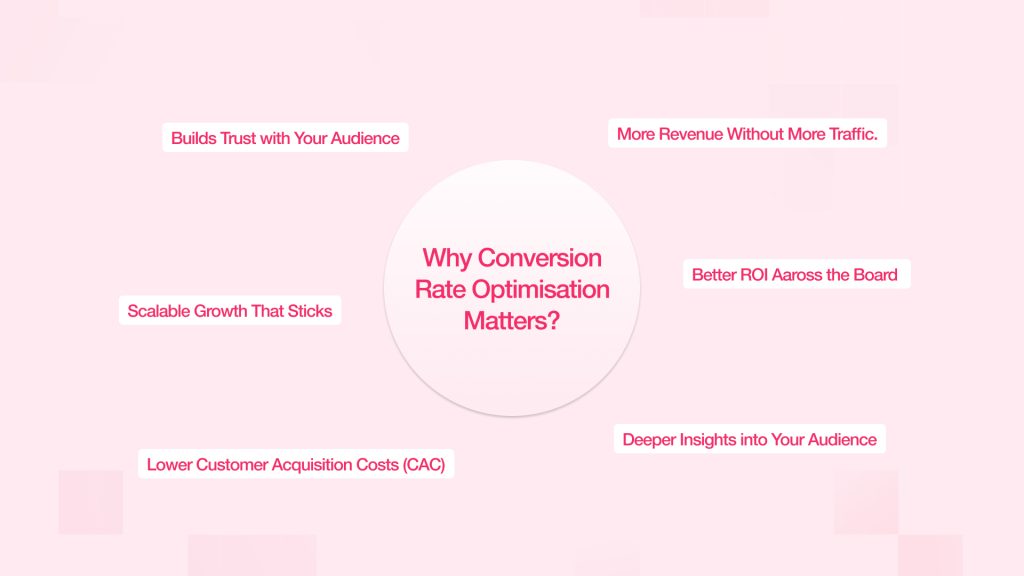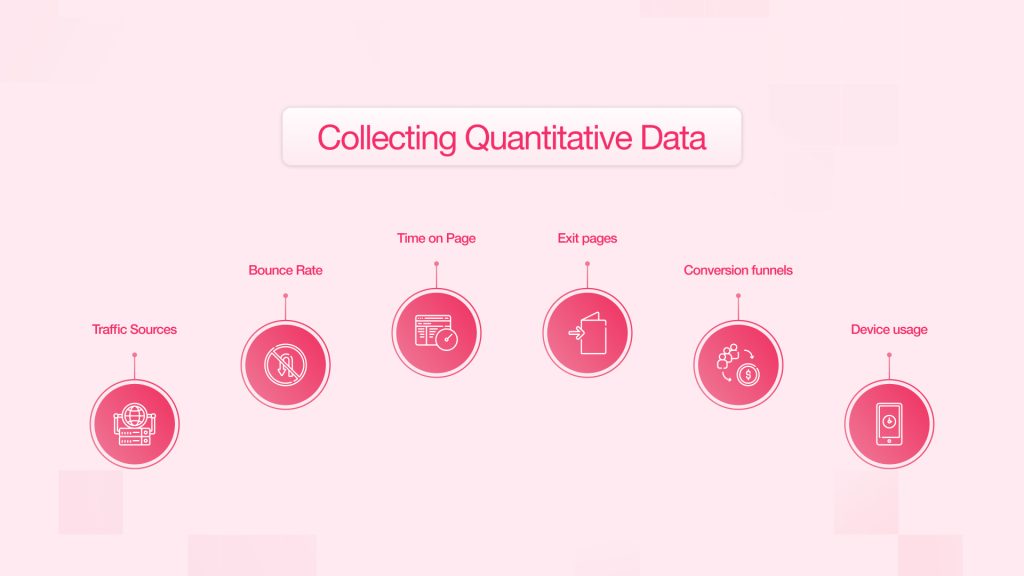What is Conversion Rate Optimisation? An Ultimate Guide

Have you ever questioned whether you’re actually maximising the number of visitors to your website? The fundamentals of conversion rate optimisation are explained in this essay in a very understandable manner. We’re talking about practical tactics and simple procedures that will help convert more of your visitors into tangible outcomes, so it’s not simply theory. Getting more out of what you already have is everything. Whether your goal is to increase revenue, signups, or something else.
What Is Conversion Rate Optimisation?
Getting visitors to visit your website is no longer enough. That’s only one aspect of the game. What they do once they’re there is what counts. Conversion Rate Optimisation, or CRO, can help with that. Helping more of your visitors complete important actions, such as making a purchase, completing a contact form, subscribing to your newsletter, downloading an e-book, or even initiating a live chat, is essentially the goal. CRO is a clever, methodical approach to converting clicks into tangible outcomes.
Making the most of the people who are already visiting your website is the goal of CRO, not merely increasing the number of visitors. Consider your website to be similar to a physical business. Increasing foot traffic is certainly a good thing. But CRO is more about reorganising the shelves, honing your sales pitch, and making checkout really simple.
Additionally, it is entirely based on facts. You can improve the user experience by analysing how users interact with your website using search, maps, or listings like Google My Business for identifying areas where they have difficulties and making intelligent adjustments. The outcome? Increased income from each visitor, reduced expenses to acquire new clients, and improved returns on your marketing investment.
Understanding Conversions and Conversion Rates
Before we jump into how to optimise things, let’s clear up what a “conversion” means—and how you figure out your “conversion rate.”
A conversion is basically any action you want someone to take on your site. It all depends on your goals. For some businesses, it might be a sale. For others, it could be a newsletter signup, filling out a form, downloading something, or even just clicking a certain button.
- Ecommerce: Think product purchases, adding stuff to a cart, finishing the checkout, or signing up for email updates.
- Lead generation (like B2B or service-based businesses): This might be things like filling out a contact form, downloading a whitepaper, booking a demo, or signing up for a free trial.
- Media or publishing sites: Conversions here could be newsletter signups, more ad views, getting people to read more articles, or interacting with recommended content.
- SaaS: You’re probably looking at free trial signups, demo requests, or getting users to upgrade to a paid plan.
Your conversion rate is basically the percentage of people who do what you want them to do on your site. You just take the number of conversions, divide it by the total number of visitors (to your whole site or a specific page), and then multiply by 100. Simple math, but super important.
Conversion Rate = (Number of Conversions / Total Number of Visitors) × 100
Let’s say your site gets 10,000 visitors in a month and you make 250 sales. That means your conversion rate for sales is (250 ÷ 10,000) × 100, which comes out to 2.5%. Knowing this number is key—it gives you a starting point to track how well your optimisation efforts are actually working.
Why Conversion Rate Optimisation Matters?
You really can’t overstate how valuable Conversion Rate Optimisation is—it can have a huge impact on how your business grows and stays profitable. Here’s why it matters:

More Revenue Without More Traffic
One of the biggest perks of CRO is that it helps you squeeze more value out of the visitors you already have. You don’t have to spend extra on ads or marketing—if more people take action on your site, your sales or leads go up. Simple as that.
Lower Customer Acquisition Costs (CAC)
If your site does a better job converting visitors, each new customer costs you less. For example, if you boost your conversion rate from 1% to 2%, you’re basically getting double the results from the same amount of traffic—and your CAC just got cut in half.
Better ROI Aaross the Board
CRO makes your existing marketing efforts work harder. Whether it’s SEO, paid ads, or content marketing, getting more conversions from the same traffic means your return on investment goes up—without needing to throw more money at it.
For more on planning and budgeting, see how much it costs to build a website in the UK.
Deeper Insights into Your Audience
One of the underrated benefits of CRO is how much you learn about your users. You start to see what they’re looking for, how they move through your site, and where they get stuck. That kind of info isn’t just helpful for tweaking your site—it can shape your overall strategy, guide product decisions, and improve the customer experience as a whole.
Scalable Growth That Sticks
Unlike just pumping more money into ads to get extra traffic, CRO gives you improvements that actually last. Once your site’s better at converting, it keeps working in your Favor over time—so you can grow without constantly increasing your spend.
Builds Trust with Your Audience
When your website is easy to navigate, answers people’s questions, and clearly shows them what to do next, it creates a smoother, more reassuring experience. And that kind of experience builds trust—something that’s key if you want folks to come back or stick around for the long haul.
The Conversion Rate Optimisation Process
Good Conversion Rate Optimisation isn’t just guesswork—it follows a clear, step-by-step process. The exact approach might differ a bit depending on the team or tools, but the core steps are pretty much the same across the board.
Research and Data Collection
First things first—you need to really understand your users and figure out where things could be working better. This starts with collecting both hard numbers and more personal, user-focused feedback.
Quantitative data:
Tools like Google Analytics give you solid insights into how people are behaving on your site. Some key things to look at:

- Traffic sources: Where are your visitors coming from—search engines, social media, email, etc.?
- Bounce rate: If people are landing on a page and leaving right away that’s a red flag—especially on pages meant to convert.
- Time on page: Are folks sticking around or clicking away fast?
- Exit pages: Which pages are people leaving from most often?
- Conversion funnels: Track how users move through the site on their way to a conversion—and where they’re dropping off.
- Device usage: Are most of your visitors on mobile, desktop, or tablets? Make sure the experience works well for how they’re actually browsing.
Qualitative Data (User Feedback):
This kind of data helps explain the why behind the numbers.

- Heatmaps: These show you exactly where people are clicking, scrolling, and spending the most time on a page.
- Session recordings: You can actually watch how individual visitors move through your site and interact with it.
- Surveys and polls: Sometimes the best way to find out what’s going on is just to ask. Get direct feedback about what’s working—or what’s getting in the way.
- User testing: Watch real people try to complete tasks on your site and hear what they have to say about the experience.
- Expert reviews: A CRO pro can take a look at your site through the lens of usability best practices and point out areas for improvement.
Formulating Hypotheses
Once you’ve got your data, it’s time to come up with clear, testable guesses—aka hypotheses—about what might boost your conversion rate. A good hypothesis usually looks like this:
“Because we noticed [A], we think that changing [C] for [D] will make [E] happen. We’ll know we’re right when we see [F].”
Here’s an example:
“Because we saw a lot of people leaving on our product page (A), and surveys told us they had trouble finding shipping info (B), we think adding a clear, easy-to-find shipping section (C) for new visitors (D) will boost add-to-cart clicks by 5% (E). We’ll know it worked if our add-to-cart rate goes up by 5% and the results are solid over two weeks (F).”
It’s all about making smart guesses you can actually test and measure.
Prioritisation:
Not every hypothesis is going to move the needle or be easy to test. So, it’s smart to prioritise your tests based on a few things:
- Potential impact: How big of a difference could this change actually make?
- Ease of implementation: Is it something quick and simple, or will it take forever to roll out?
- Data certainty: How sure are you that the data behind this idea is solid?
- Traffic volume: You want to test on pages that get enough visitors so you can see meaningful results without waiting forever.
Focusing on these helps you spend your time and resources where they’ll do the most good.
Testing and Experimentation
Now it’s time to actually test your hypotheses. The most common ways to do this are A/B testing and multivariate testing.
- A/B testing: You create two versions of a page—A and B. Some visitors see version A (the control), and others get version B (the new variation). Then you see which one does better.
- Multivariate testing (MVT): This one’s a bit more advanced—you test several different elements on the same page at once to figure out which combo works best. It needs more traffic to get good results, though.
There are plenty of tools to help with this stuff, like VWO, Optimizely, and Google Optimise (even though it’s being phased out, the basics still apply). These platforms make running and managing tests way easier.
Analysis and Implementation
After your tests have run long enough and the data’s solid, it’s time to dig into the results.
- Winning variations: If a version clearly beats the control, go ahead and make those changes permanent.
- Losing variations: If it doesn’t perform better, no worries—just scrap it and figure out what you learned. It’s not a failure, just part of the process.
- Keep iterating: CRO never really stops. Every test, win or lose, teaches you something new. Use those insights to come up with fresh ideas and keep tweaking your site.
It’s all about constant improvement, little by little.
Key Elements for Conversion Rate Optimisation
Every website’s different, but some things almost always play a big role in improving conversion rates. Paying attention to these can really payoff:
- User Experience (UX) design: Making your site easy and even enjoyable to use is huge. That means clear navigation, a sensible layout, and simple ways for people to interact.
- Website copy and messaging: The words on your site really matter. You want clear, straightforward, and convincing copy that speaks to what your visitors care about and shows them why they should take action. This goes for headlines, the main content, and those all-important calls-to-action.
- Calls-to-Action (CTAs): CTAs are super important. They should stand out, use clear, action-driven words, and make it obvious what the next step is. Try mixing up where you put them, their colour, and the wording to see what clicks best.
- Landing page optimisation: Since landing pages often give people their first impression, they’ve got to be focused and match what brought visitors there. They should guide users smoothly toward whatever action you want them to take.
- Page load speed: Nobody likes waiting forever for a page to load—it’s a huge conversion killer. Make sure your images, code, and servers are all optimised, so pages pop up fast, no matter the device.
- Mobile optimisation: Tons of folks browse on their phones or tablets these days, so your site has to look and work great on smaller screens. Being fully responsive isn’t just nice—it’s essential.
- Trust signals: Building trust is huge. Things like customer testimonials, reviews, security badges, privacy policies, and case studies all help people feel confident about your site and your business.
- Forms: Forms can easily trip people up. Keep them short and sweet, only ask for what you really need, use clear labels, and if possible, add real-time feedback so users know they’re doing it right as they go.
- Visuals (images and videos): Good-quality images and videos grab attention and often get the message across way better than just words alone.
- Personalisation: Showing users content or experiences that feel tailored to them—based on their behaviour or who they are—can make your site feel more relevant and boost the chances they’ll take action.
Need a Stunning Web Design and Development Services?
We Can Help!
Conversion Rate Optimisation and SEO
People often think of Conversion Rate Optimisation (CRO) and Search Engine Optimisation (SEO) as totally separate things, but really, they work best together. SEO’s all about getting the right people to your site, while CRO is about turning those visitors into customers or leads. When you combine them, you get a pretty powerful one-two punch for growing online.
Here’s how to bring SEO and CRO together:
- User-focused content: Both SEO and CRO thrive on content that actually helps your visitors. Good, useful content that answers their questions keeps people interested (which is great for CRO) and tells search engines your site is relevant (which helps with SEO).
- Page speed and mobile experience: These aren’t just SEO ranking factors—they’re also huge for user experience and conversion rates. A site that loads fast and works smoothly on phones will do better all around.
- Keyword intent: It’s important to really get what people mean when they search. For info-seekers, give clear, thorough answers. For people ready to buy or take action, make sure your CTAs and product info stand out. Matching content to what visitors wants helps with both rankings and conversions.
- A/B testing with SEO in mind: When you run A/B tests, be careful not to hurt your SEO. That means avoiding things like “cloaking” (showing different stuff to users vs. search engines) and keeping your main page content consistent so search engines don’t get confused.
- Metadata optimisation: Writing catchy title tags and meta descriptions doesn’t just help you get clicks from search engines (SEO)—it also sets the right expectations so visitors know what they’re getting. That clarity can actually boost conversions once people land on your page (CRO).
- Site structure and navigation: Having a simple, logical layout is a win-win. It makes it easier for search engines to crawl your site and helps visitors find what they need quickly, guiding them smoothly toward taking action. Good for SEO, good for CRO.
Need SEO Guidance and Support to boost your website rankings?
Our Experts Can Help!
Conclusion
Conversion Rate Optimisation is honestly a game-changer for any business online. It’s not just about getting more visitors—it’s about making every single visit count. By digging into real user behaviour, spotting where people get stuck, and constantly testing new ideas, you can boost conversions, cut costs, and grow in a way that lasts.
It’s really an ongoing process of learning and tweaking, always keeping the user experience front and centre. When you invest in CRO, you’re investing in truly understanding your customers and making your website work harder for what you want to achieve. It’s all about turning clicks into meaningful actions—and that’s where real online success comes from.
 Shopify
Shopify

















